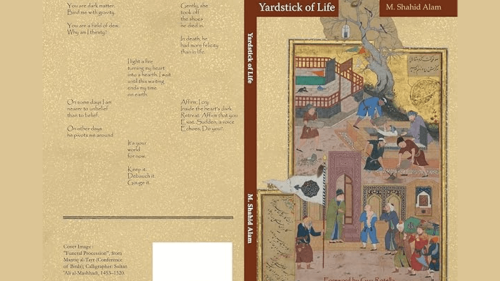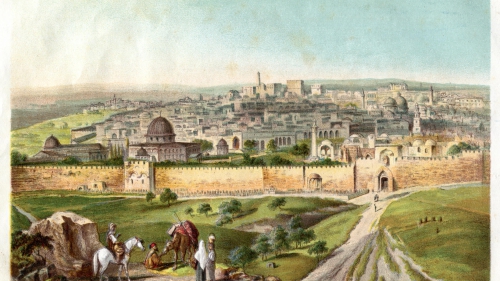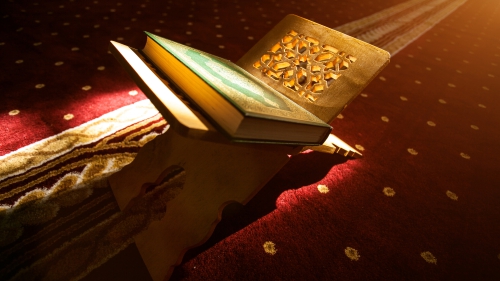From Past Scholars to Innovators of Tomorrow

On February 29th, 2020, the last day before the Corona pandemic lockdown started in the USA, a major conference was held at University of Texas at Dallas, Texas, organized by the Institute of Medieval and post Medieval Studies (IMPMS). 600 participants, scientists, academicians, community leaders, parents, teachers, and students attended the conference.
IMPMS was established in 2001 to make people aware of the great contributions that Muslim medieval scholars made to world civilization by presenting and disseminating written and audiovisual material, as well as organizing conferences on this subject. The president of the organization and other members presented papers at the International Congress on Medieval Studies at Western Michigan University, Kalamazoo Michigan, as well as in St. Louis, Missouri, Dallas Texas and several other cities, and have published numerous papers and edited two books: Muslim Contributions to World Civilization and Islamic Intellectual Heritage and its Impact on the West.
Two years ago, IMPMS joined hands with another organization, DiscoverStem, an organization which inspires and trains young Muslim students to become innovators and future scientists and presents joint conferences and educational programs to promote education in science and technology.
Muslim holy book Quran is the source of guidance to Muslims. The first revealed verse of the Quran starts with the word IQRA (read) and shows importance gaining knowledge. “Read: in the name of your lord who created man from clot, and your lord is most generous, who taught by the pen, taught that which he knows not” (96:1-5). And Allah also reminds Muslims that every Muslim man's woman's prayer should be: “Rabbi zidni ‘Ilmaa” (O Lord, increase me in ‘ilm (knowledge) (20-114). The purpose of gaining knowledge is to understand, appreciate and unravel the mysteries of his creation. The Qur’an repeatedly urges humankind to understand the forces of nature for the benefit of human beings and their intellectual growth, and it has brought to humanity an interest in scientific thinking. Qur’an says “We did not create heaven and earth and all in between without purpose,” (38:27) These verses urge man to study, explore, analyze and understand the marvelous creations of Allah (SWT) for the benefit of mankind and express profound gratitude to Allah (SWT) for his unbounded generosity. This divine gift for man to acquire knowledge of the unknown has been a motivating factor for the advances in science and technology and progress of human civilization with the passage of time. Because of the Qur’anic emphasis on the use of reason in all deliberations, Muslim scientists engaged in research and showed that there was no incompatibility between reason and Revelation.
A few years ago, Carly Fiorina, former Chair CEO of Hewlett Packard, and a presidential candidate described the Islamic heritage by noting: “It was driven more than anything by invention. Its architects designed buildings that defied gravity. Its mathematicians created the algebra and algorithms that would enable the building of computers and the creation of encryption. Its doctors examined the human body and found new cures for disease. Its astronomers looked into the heavens, named the stars, and paved the way for space travel and exploration.”
The major theme for the IMPMS conference was designed particularly for the newer generations to become familiar with the scientific work of classical medieval scholars and to show the creative work of young Muslim students who won national prizes for their scientific thinking and innovative work under the guidance of Mr. Faizan Mirza an accomplished aerospace scientist and the founder and president of Discover STEM.
Mr. Mirza started teaching innovation classes in 2016, with his passion for mentoring and innovation. The DiscoverSTEM Innovation Program is the only program in the world which boasts of taking a 10-year old child and converting him into an innovator of patentable systems. Over the last two years alone, DiscoverSTEM has mentored around 70 young patent applicants, winning 44 global innovations and competition titles, mostly conducted at NASA and 40 young inventors have been featured in national and international print and electronic media. Over the last several months, DiscoverSTEM has sent students to Harvard, Stanford, and Duke with over $1.5 million in scholarships offered. 44 of these kids have been featured in national and international media, won 40 innovation titles at various NASA innovation competitions, Conrad Innovation Challenge, Future City Competition and America's Top Young Scientists Challenge.
Dr Basheer Ahmed, founder president of IMPMS, gave a brief history of IMPMS, its mission and accomplishments. He then briefly described the monumental work of a few great Muslim medieval scientists and scholars (700—1400 CE) and how they influenced the world. Dr. Ahmed pointed out that the pioneering research work was done a thousand years ago when computers and modern research labs were not available. Writing hundreds of books without computers is itself a miracle. Some background of these scientists and their work:
JABIR IBN HAIYAN (Geber) (721- 803 CE) from Tus, Iran. known as the father of chemistry. was the first scientist to introduce experimental investigation (tajribah) into chemistry by perfecting techniques of crystallization, distillation, sublimation, and evaporation and developed several instruments to perform these tests.
AL-KHAWARIZMI (780- 840 CE) from Khiva, Uzbekistan was perhaps one of the greatest mathematicians who ever lived. He introduced, Algebra and algorithm (the europeanized pronunciation of “al-Khawrizmi”) and he is regarded as the father of algebra and computer science. Our modern technological industry would not exist without the contributions of the Muslim mathematicians like Al-Khwarizmi.
AL-RAZI (864 - 932 CE) from Ray, Iran. A renowned physician of the medieval world whose books on medicine were among the most influential medical books of the medieval age and were used as textbooks of medicine for 500 years in the Middle East and Europe. He was the first physician to describe how to differentiate between measles and smallpox and wrote about specific treatments. He proposed remedies on animals first to evaluate their effectiveness and side effects giving the concept of development of future research labs. He wrote 200 books on various topics including the diagnosis and treatment of human disease.
AL-ZAHRAVI (Abulcasis) (936 - 1013 CE) from Cordova, Spain. He became one of the most renowned surgeons of the Muslim era and is considered the father of surgery, whose comprehensive medical text influenced European surgical procedures for 500 years, until the Renaissance. He described in detail various aspects of surgical treatment based on operations he performed. His books also contained illustrations of all the surgical instruments that he used. These books contain drawings of more than 200 instruments and constituted the first illustrated independent work on surgery. His books can be found in the library of Congress in Washington DC.
AL-HAITHAM (Alhazen) (965 - 1040 CE) from Basrah, Iraq. He was one of the most eminent physicists whose contributions to optics and scientific methods are outstanding. He contradicted Ptolemy’s and Euclid’s theory of vision—that objects are seen by rays of light emanating from the eyes. He proved that rays of light bounce on an object and are then directed into the eyes, which make an object visible. During his experiments, he invented the pinhole camera, the world’s first camera. Ibn al-Haitham was regarded as the first scientist to confirm a theory by observation and experimentation. His findings on geometrical optics in 965 CE were later used in European inventions, such as cameras and sophisticated eyeglasses which are erroneously attributed to Snell’s laws.
IBN SINA (980 - 1037 CE) from Bukhara, Uzbekistan. By the age of ten, he had become well versed in the study of the Quran and Islamic sciences. He compiled at a very young age the entire medical knowledge available from ancient times in his encyclopedic work on medicine, Quanoon fil Tib (The Canon of Medicine). He also documented his original contributions, such as the recognition of the contagious nature of phthisis and tuberculosis and the spread of diseases through water and soil. His books were translated and used as textbooks for medicine for several centuries in Europe. He wrote 450 books on various subjects.
IBN RUSHD (Averroes) (1128 - 1198 CE) from Cordova, Spain. Ibn Rushd made remarkable contributions in philosophy, logic, medicine, and jurisprudence He was a well-known commentator on Aristotle and was regarded as the greatest rationalist of his age. He showed the importance of reasoning and rationalism for Muslims, Jewish, and Christian religious dogma. According to Philip Hitti a historian Ibn Rushd had a great influence on Western thought from the l2th to the l6th centuries. His ideas influenced the transformation of thought in Europe and contributed in renaissance.
IBN KHALDUN (1332-1395 CE) from Tunisia. He wrote Muqaddima, the first volume of world history, which gave him a special place among historians, sociologists, and philosophers. He documented the psychological, economic, environmental, and social factors that contributed to the advancement of human civilization. He postulated the theory of cyclical change in human civilization caused by dynamically changing social, economic, political, and geographical factors. His writings on the development of history in its totality gave rise to a new discipline, that of social science. As a historiographer and a philosopher of the science of history, he has no equal thus far in any age or country. (Encyclopedia Britannica)
Dr. Ahmed also mentioned the names of most well-known medieval scholars, such as, Abu Raihan Al Biruni (Astronomy), Al Battani (Astronomy), Al Farabi (Sociology), Al Ghazali (Philosophy), Al Idrisi (Geography), Al Al Mawardi (Political Science), Ibn Al Baitar (Botany), Al-Kindi (Philosophy), Ibn Zuhr (Surgery), Omar Khayyam (Astronomy), Nasir Al Din Al Tusi (Geometry), Jalal Al Din Rumi (Sufi Poet). He also referred the audience to the exhibit of photos and description of the pioneering work of the above-mentioned scholars in the exhibition hall outside the auditorium.
The Keynote speaker at the conference, Dr Hashima Hassan, the senior program scientist at NASA, inspired the audience especially the young students by describing her own story about growing up in a modest conservative but an educated family in India. She obtained her PhD from Oxford University, England in theoretical nuclear physics in 1976. Her love for space dated back to 1950’s when she saw the sputnik space module from the backyard of her grandmother’s house in India.
She went to all-girls school and when the school offered an opportunity for the most talented girls to study science in high school, she grabbed it. When the first man landed on moon, she dreamed of working at NASA as space scientist. She vigorously pursued her goals and won a scholarship to Oxford University and materialized her dreams in 1994 when she joined NASA headquarters to manage space missions and research programs in astrophysics.
Since she joined NASA in 1994, she has been the program scientist for 12 flight missions and the lead scientist for the astrophysics analysis program. She currently works as a senior program scientist at the James Webb Space Telescope and lead for astrophysics education.
She grew up in a hostile environment where a young woman wishing to pursue a scientific career, rather than getting married and raising a family, was not acceptable. But she pursued her dreams and with hard work she achieved her goals. This is how the scientists and innovators reach the stars. It was a very inspirational and motivational speech. She concluded by saying that her mother and schoolteachers were motivators. They did not have enough knowledge to provide her the direction, but they taught her to believe in herself, to dream and to succeed.
The next speaker was Col. Richard Graham who was an SR-71 pilot, flight instructor and safety team representative with the FAA, author, speaker, and aviation consultant. He gave an inspirational speech about his personal experiences as an SR 71 (Aka the Blackbird, The World's Fastest Plane) pilot. After leaving the Air War College in June of 1982, he was assigned to the USAF Headquarters (Pentagon) to work in Programs and Resources as a strategic force programmer. As a Vice Wing Commander of the 9th Strategic Reconnaissance, he flew one of the fastest airplanes in the world; the SR-71 Blackbird. He described the unique experiences he had with the highest excitement and indescribable inner feelings. Colonel Graham showed various clips of his experiences as command pilot with more than 4,600 military flying hours. We saw a great admiration and awe on the faces of young students when Colonel Graham was describing his experiences flying the SR71 and showing the video clips of the Blackbird.
Future scientists and innovators
DiscoverSTEM has been training young students to become inventors/innovators. They have been doing this training very successfully for several years. The young students create their own projects by researching current problems, usually global in nature that affect a large number of people.
One team being trained at DiscoverSTEM since March of 2018 was for participation in the NASA AMES Space Settlement Competition --- 10,000 candidates from 20+ countries globally entered.
For the "Grade 7 and Younger" age group, DiscoverSTEM’s team of 7 kids won 1st prize. You can see more about their invention "Spaceberg".
Among other recent achievements was one of their young innovators who won the award of Texas Top Young Scientist by inventing a hand-held device which was designed to detect lead in paint.
The Future City Competition is a nationwide competition for middle school students that challenges them to research, design and build futuristic cities that solve global problems. This year Team Pawlington, consisting of 3 main team members, a backup, an educator and a mentor, from DiscoverStem, won first place in the 20th annual North Texas Regionals among 73 participating schools. Using recycled material from around their homes, the team created their futuristic city, called Pawlington. Pawlington stands for Pure Accessible Water with the word “lington” meaning "Gift of God" originating from Gaelic language. This year's theme was finding a futuristic method of solving the global problem of clean water. Team Pawlington was able to design a patent-pending water filtration system.
Seventy students who were mentored at DiscoverStem received recognition and certificates at the end of the IMPMS conference. These students worked in various teams which won the NASA “Texas State’s Young Scientists Award” and other state and national awards, credits and pending patents. There was a grand exhibit outside the UTD auditorium of the several projects the young innovators have presented in national and international competitions.
This was a unique conference which presented the works of great Muslim medieval scholars and current young Muslim innovators and future scientists. Talking about the history of the golden age of Islam will make us aware of our glorious past and serve as a source of inspiration. What we are attempting to nurture is the development of future Muslim scientists and innovators who will follow the footsteps of great Muslim scholars and become future scientists themselves. This is a unique presentation and most probably the first one of its kind in the world.
Dr. Basheer Ahmed is the former professor of psychiatry, South Western Medical School, Dallas, Texas, and chairman emeritus MCC for Human services North Texas.
Topics: History, Islamic Culture And Civilization, Islamic Golden Age, Muslim Scholars, Muslim Scientists
Views: 3443
Related Suggestions
















